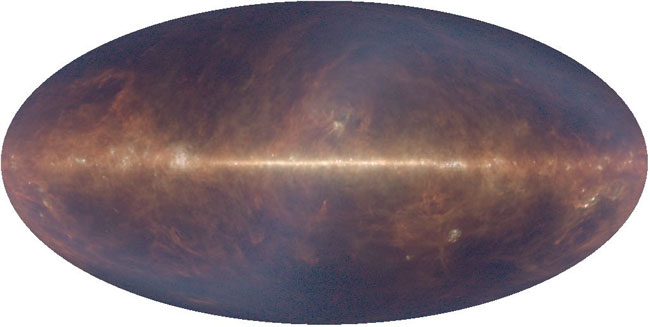Massive stars in our Milky Way Galaxy live spectacular lives. Collapsing from vast cosmic clouds, their nuclear furnaces ignite and create heavy elements in their cores. After a few million years, the enriched material is blasted back into interstellar space where star formation can begin anew. The expanding debris cloud known as Cassiopeia A is an example of this final phase of the stellar life cycle. Light from the explosion which created this supernova remnant would have been first seen in planet Earth's sky about 350 years ago, although it took that light about 11,000 years to reach us. This false-color image, composed of X-ray and optical image data from the Chandra X-ray Observatory and Hubble Space Telescope, shows the still hot filaments and knots in the remnant. It spans about 30 light-years at the estimated distance of Cassiopeia A. High-energy X-ray emission from specific elements has been color coded, silicon in red, sulfur in yellow, calcium in green and iron in purple, to help astronomers explore the recycling of our galaxy's star stuff. Still expanding, the outer blast wave is seen in blue hues. The bright speck near the center is a neutron star, the incredibly dense, collapsed remains of the massive stellar core.
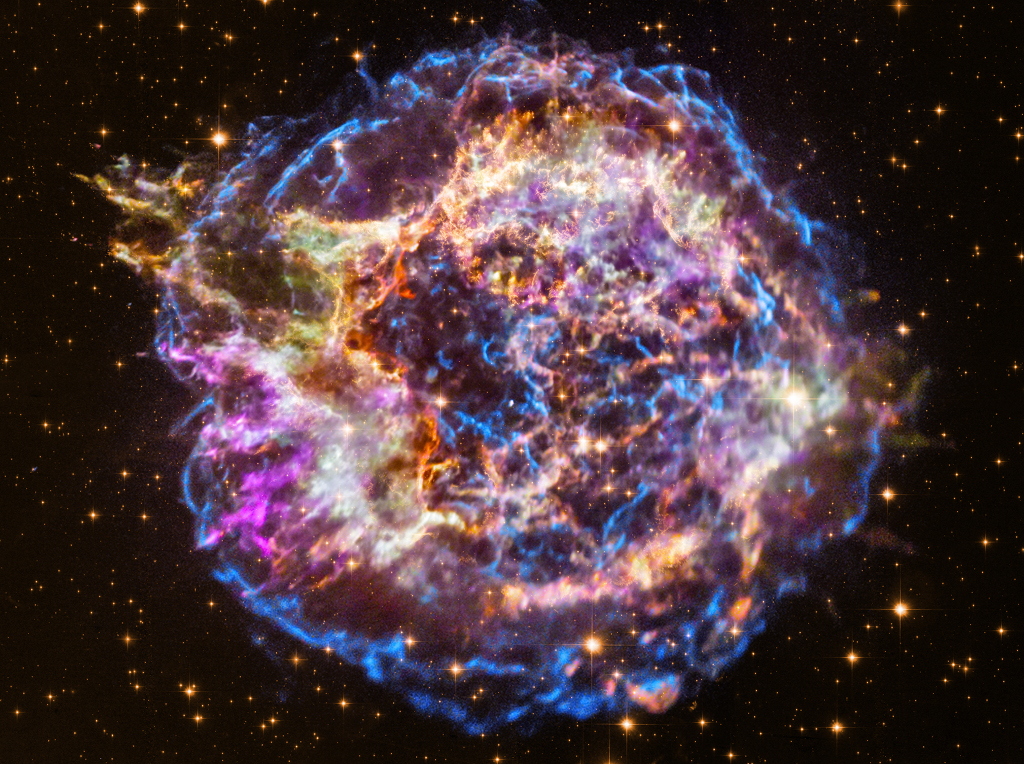
Mars won't look this good. Tonight and over the next few days, when Mars is at its closest approach to Earth in nearly 60,000 years, you might get your best view ever of our planetary neighbor. Please, though, don't expect to see this much structure, or expect to see Mars rotate so much in so brief a period. The above 20-frame movie was created from 1000 frames of a backyard webcam that were meticulously aligned, added, and digitally sequenced. Pictured, Mars appears to rotate in a time-lapse sequence, with each frame separated by 30 minutes of real time. In reality, one full Martian rotation -- a Martian day -- is only about 40 minutes longer than an Earth day. For those with access to a small telescope, here is how mars will really look.
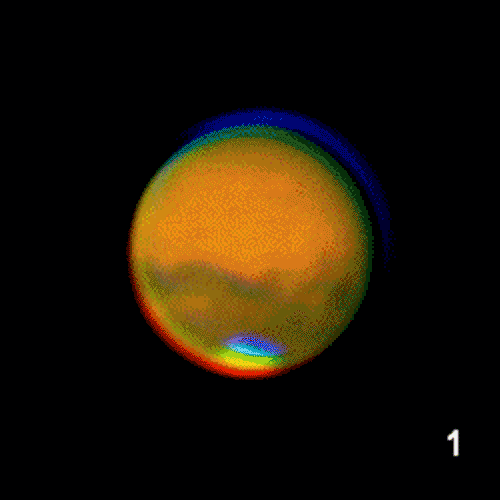
Will the Hubble Space Telescope (HST) end up in a museum? Probably not, as when it finally goes bust, current plans call for it to be de-orbited into an ocean. But this won't stop likenesses of the famous floating observatory from appearing in science museums around the globe, sometimes paired with amazing pictures it has taken. Pictured above, in a celebration of the 20th anniversary of the launching of Hubble, a replica of the telescope was given a picturesque setting in the Italian Istituto Veneto di Scienze, Lettere ed Arti in their beautiful and historic Palazzo Loredan. The scene there appears perhaps a bit surreal as the deep space imager appears over a terrestrial tile floor, surrounded by the busts of famous thinkers, and under arches reminiscent of Escher. If you're lucky, it may even be possible to find an exhibition of Hubble images near you. And if no HST model appears there, you could always build your own.
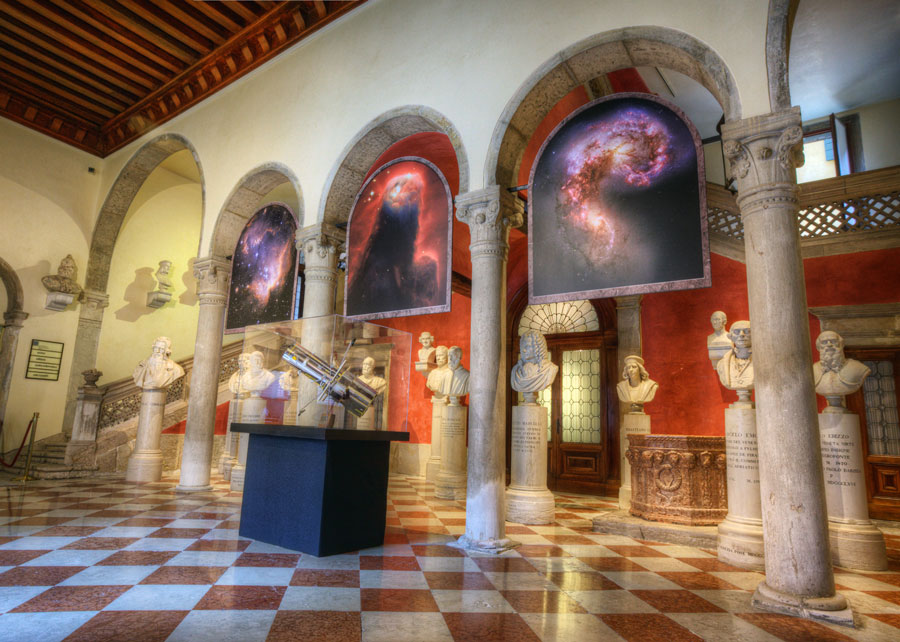
Beautiful island universe Messier 94 lies a mere 15 million light-years distant in the northern constellation of the hunting dogs, Canes Venatici. A popular target for earth-based astronomers, the face-on spiral galaxy is about 30,000 light-years across, with spiral arms sweeping through the outskirts of its broad disk. But this Hubble Space Telescope field of view spans about 7,000 light-years or so across M94's central region. The sharp close-up examines the galaxy's compact, bright nucleus and prominent inner dust lanes, surrounded by a remarkable bluish ring of young, massive stars. The massive stars in the ring are all likely less than 10 million years old, indicating the galaxy experienced a well-defined era of rapid star formation. As a result, while the small, bright nucleus is typical of the Seyfert class of active galaxies, M94 is also known as a starburst galaxy. Because M94 is relatively nearby, astronomers can explore in detail reasons for the galaxy's burst of star formation.
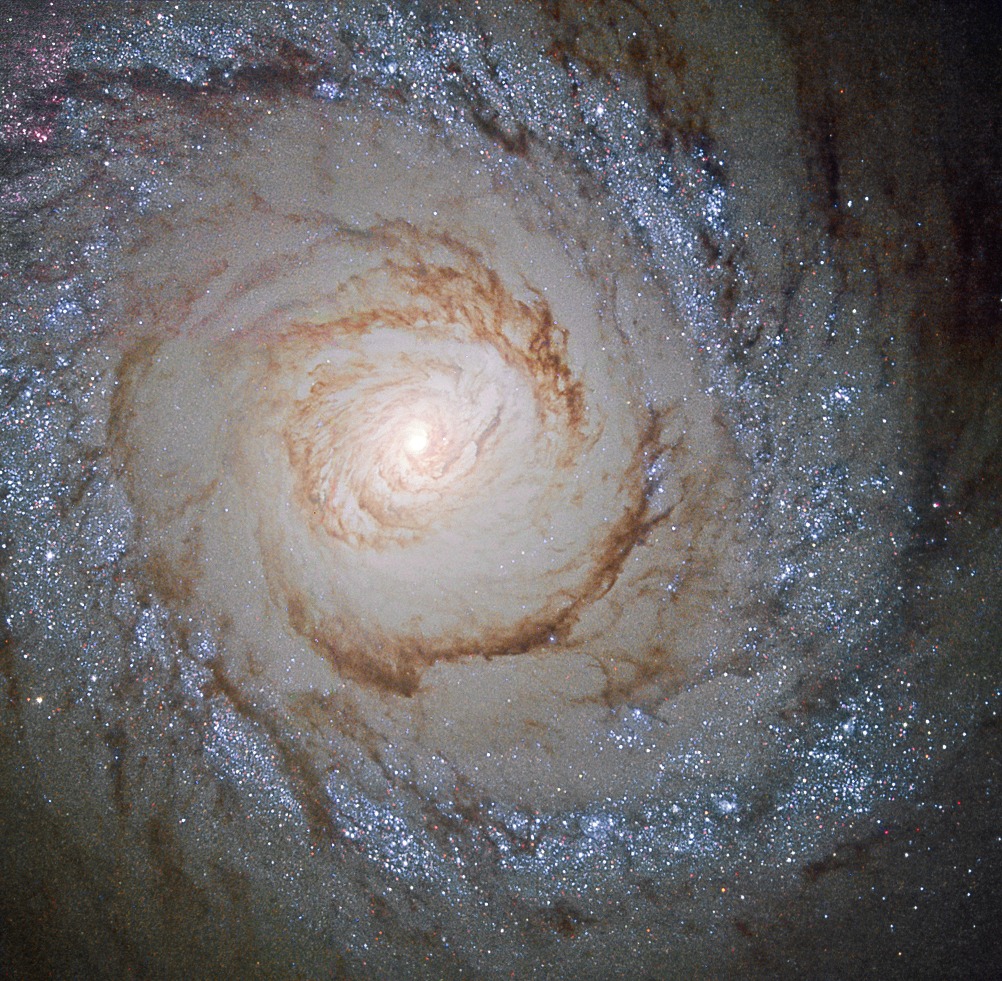
Clouds of glowing gas mingle with lanes of dark dust in the Trifid Nebula, a star forming region toward the constellation of Sagittarius. In the center, the three huge dark dust lanes that give the Trifid its name all come together. Mountains of opaque dust appear on the lower left, while filaments of dust are visible threaded throughout the nebula. A single massive star visible near the center causes much of the Trifid's glow. The Trifid, also known as M20, is only about 300,000 years old, making it among the youngest emission nebula known. The nebula lies about 5000 light years away and part pictured above spans about 20 light years. The above false-color digitally enhanced image was taken with the Gemini North telescope earlier this month.
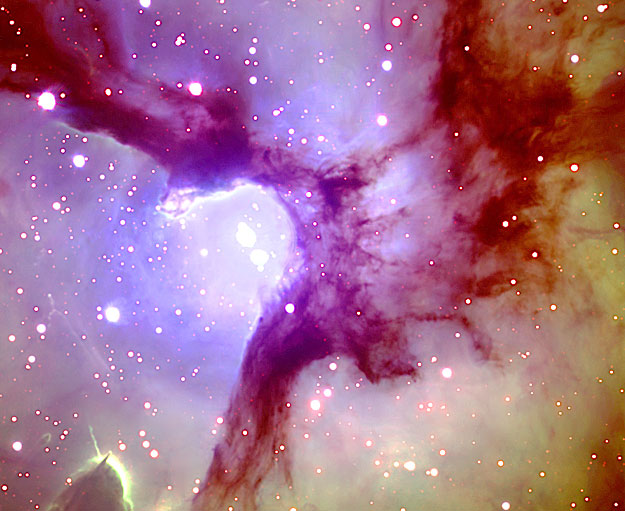
What makes NGC 6872 so long? Measuring over 700,000 light years across from top to bottom, NGC 6872 is one of the largest barred spiral galaxies known. The galaxy's elongated shape might have something to do with its continuing collision with the smaller galaxy IC 4970, visible just above center. Of particular interest is NGC 6872's spiral arm on the upper left, as pictured above, which exhibits an unusually high amount of blue star forming regions. The light we see today left these colliding giants before the days of the dinosaurs, about 300 million years ago. NGC 6872 is visible with a small telescope in the constellation of Pavo.
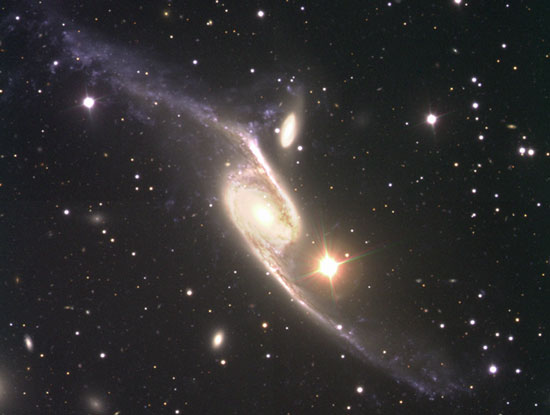
15,000 years ago a star in the constellation of Cygnus exploded -- the shockwave from this supernova explosion is still expanding into interstellar space! The collision of this fast moving wall of gas with a stationary cloud has heated it causing it to glow in visible as well as high energy radiation, producing the nebula known as the Cygnus Loop (NGC 6960/95). The nebula is located about 2500 light years away. The colors used here indicate emission from different kinds of atoms excited by the shock; oxygen-blue, sulfur-red, and hydrogen-green. This picture was taken with the Wide Field and Planetary Camera 2 on board the Hubble Space Telescope.
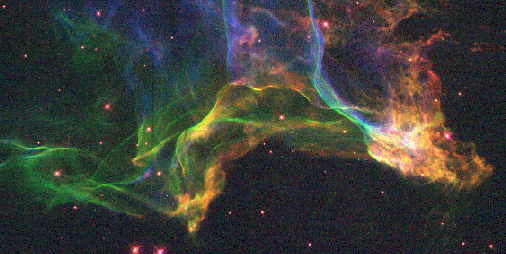
In 1865 Jules Verne predicted the invention of a space capsule that could carry people. In his science fiction story "From the Earth to the Moon", he outlined his vision of a cannon in Florida so powerful that it could shoot a "Projectile-Vehicle" carrying three adventurers to the Moon. Over 100 years later, NASA, guided by Wernher Von Braun's vision, produced the Saturn V rocket. From a spaceport in Florida, this rocket turned Verne's fiction into fact, launching 9 Apollo Lunar missions and allowing 12 astronauts to walk on the Moon. Pictured is the last moon shot, Apollo 17, awaiting its December 1972 night launch. Spotlights play on the rocket and launch pad at dusk. Humans have not walked on on the lunar surface since.
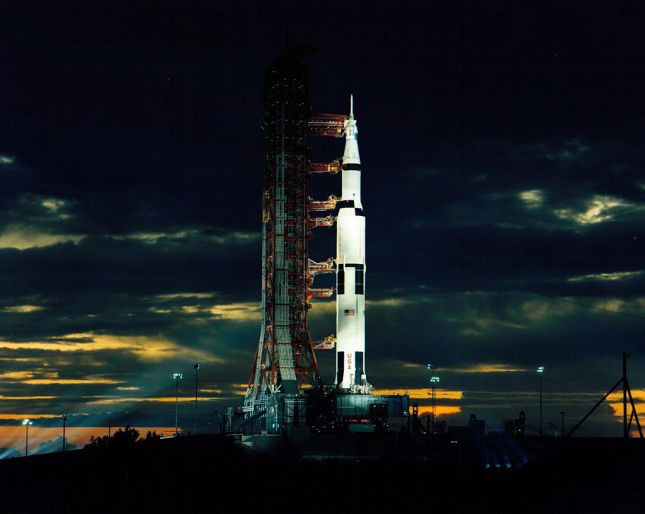
This is what the Earth looks like at night. Can you find your favorite country or city? Surprisingly, city lights make this task quite possible. Human-made lights highlight particularly developed or populated areas of the Earth's surface, including the seaboards of Europe, the eastern United States, and Japan. Many large cities are located near rivers or oceans so that they can exchange goods cheaply by boat. Particularly dark areas include the central parts of South America, Africa, Asia, and Australia. The above image is actually a composite of hundreds of pictures made by the orbiting DMSP satellites. (Editor's note: This image has become an email-attachment phenomenon! It has also generated many print requests. Unfortunately, we do not sell prints. However, a high-resolution digital version of the image is available (click here or here).
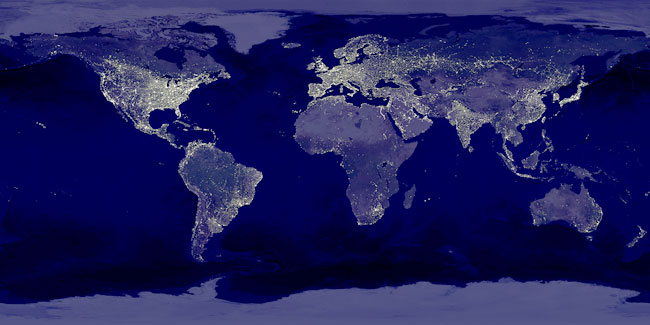
Three major sources contribute to the far-infrared sky: our Solar System, our Galaxy, and our Universe. The above recently released image, in representative colors, is the highest resolution projection yet created of the entire far-infrared sky (60 - 240 microns) created from years of observations by the now-defunct robot spacecraft COBE. Our Solar System is evidenced most prominently by the S-shaped blue sash called zodiacal light, created by small pieces of rock and dust orbiting between the Sun and Jupiter. The disk of our Galaxy is evidenced most prominently by the thin band of light-emitting dust that crosses the middle of the image. Clouds and filaments of dust in our Milky Way also make intricate patterns pervading most of the sky. Close inspection of similar images reveal that the background is not completely dark, indicating that our Universe itself provides a diffuse glow, created by dust left over from the star formation throughout the Universe.
